Have you ever struggled to touch your toes? Or maybe you’ve noticed that your hips get tight and sore after long periods of sitting and could use some mobility work. Whatever the case, improving your flexibility through a consistent stretching routine can help you move, feel, and perform better in your daily activities and workouts. The good news is that free apps for stretching and Mobility Exercises can help you achieve these objectives, from guiding you through effective protocols to tracking your progress. In this article, we’ll cover the best free apps for stretching and flexibility to help you find the perfect fit to improve your mobility all without spending a dime.
One excellent option to consider is Pliability’s mobility app. The app offers dozens of free routines and protocols designed by experts to improve flexibility and mobility for better performance and injury prevention.
What is Stretching & Why it is Important
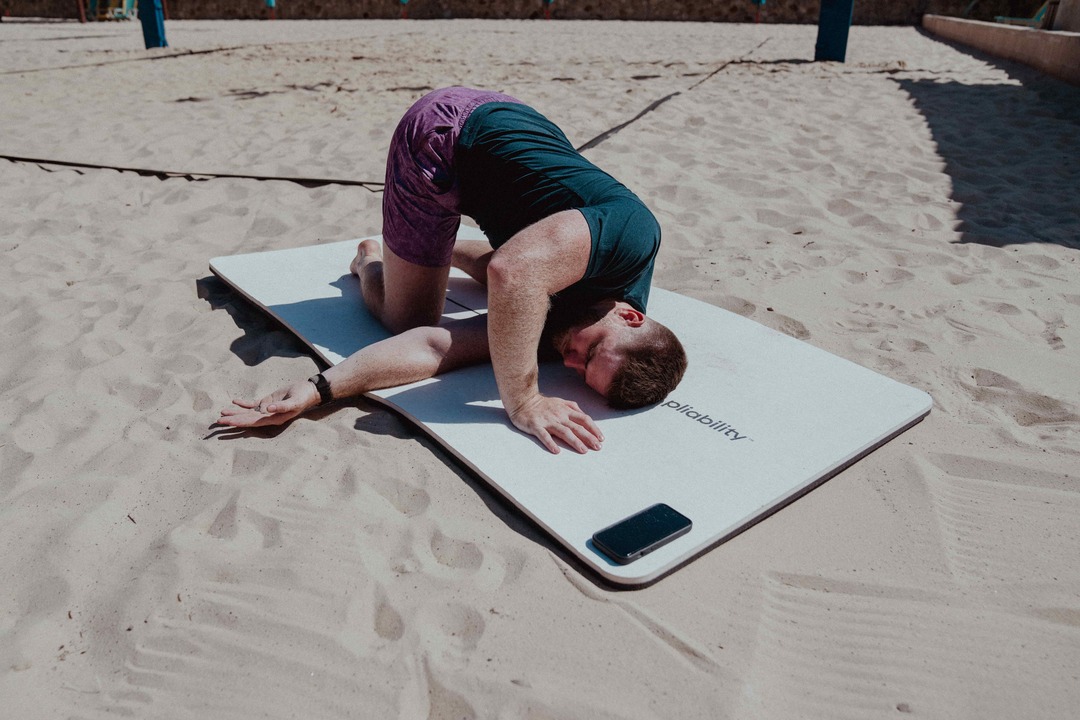
Stretching is any movement that lengthens your muscles (and along with them, the tendons, ligaments, and connective tissue) even temporarily, physical therapist and strength coach Ivan Hernandez, D.P.T., C.S.C.S., owner of Executive Park PT and Wellness in New York, tells SELF. Every time you move your body, something is getting stretched, Candace Harding, D.P.T., a physical therapist and registered yoga teacher in Vienna, Virginia, tells SELF. There are several different types of stretches.
Static stretches
Static stretches involve moving into an end range of motion and then holding that position, physical therapist and strength coach Ravi Patel, D.P.T., C.S.C.S., founder of Impact Health and Performance in Atlanta, tells SELF. Examples of static stretches include pulling your heel to your butt and holding it there to stretch your quad or bending and pulling your elbow overhead to stretch your tricep.
Dynamic stretches
Physical therapist Cydni Matsuoka, D.P.T., C.S.C.S., from SPEAR Physical Therapy in New York City, tells self that dynamic stretches involve active, controlled movements performed through a larger range of motion. These include:
- Walking lunges
- Arm circles
- Deep squats
She explains that dynamic stretches are often done pre-workout to prepare muscles, tendons, and ligaments for exercise.
Ballistic stretches
There are also ballistic stretches, which involve aggressively bouncing or moving into an end range of motion, and proprioceptive neuromuscular facilitation (PNF) stretches, which involve contracting and relaxing muscles to increase a stretch. Because ballistic stretching is not recommended for the general population (it can be dangerous), and PNF stretching is often done with the assistance of a professional, we’re not going to focus on those two forms of stretching in this article.
Why Stretching is Important
While the research on stretching is a bit mixed, there are some legitimate mental and physical benefits to incorporating it into your routine, whether you stretch pre-workout, at the end of your session, or at another time during the day. People who make time for stretching may find it helps their workouts and daily lives feel a little (or a lot) better.
Stretching Improves Flexibility
Flexibility is the range of motion of a joint, or group of joints, certified exercise physiologist John Ford, owner of JKF Fitness & Health in New York City, tells SELF. Stretching can increase your range of motion temporarily and in the long term. The temporary gains may result from your nervous system becoming more tolerant to a stretch position, says Patel.
These gains often disappear within a day or even a few hours. To lengthen the muscle and thus improve your range of motion long-term, he says you need to stretch diligently about five to six days a week.
Stretching Can Help You Better Recruit Your Muscles When Working Out
If you stick with a regular stretching routine, you may see an increase in your range of motion and an improvement in your performance. Ford explains it this way: The more range of motion you have, the more muscle you can activate.
For example, if you have a limited range of motion in your hamstrings, you might only be able to activate 40% of the muscle when performing a single-leg deadlift. But if you increase your hamstring flexibility, you can activate 60% of that muscle. The result? You’ll gain strength, Ford explains, allowing me to lift more weight and thus get even stronger. He adds that more range of motion can also help me perform a broader range of exercises.
Stretching Makes Day-To-Day Life Feel Easier
Increasing your flexibility won’t just improve your workouts; it can also make everyday life better, says Ford. You may not realize it, but many daily tasks involve flexibility, like squatting to sink in and out of a chair, leaning over to get in your car, and bending down to scoop up your toddler. By boosting your flexibility with stretching, you can perform these small but essential day-to-day movements more easily and effectively.
Stretching Primes You For Your Workout
Experts typically recommend dynamic stretches before a workout. That’s because pre-workout dynamic stretches are “a way of moving slow before you move fast,” says Hernandez. By doing this, “you're preparing your body to work efficiently in order to both produce and absorb high forces,” he explains.
Ford says dynamic stretches can also help fire up the mind-muscle connection. The mind-muscle connection is the notion that you can help your muscles work more efficiently during a workout by thinking about the ones you activate as you move. For example, if you have a solid mind-muscle connection when you’re deadlifting, you can make sure that your hamstrings and glutes are engaging and doing the work just as they should be, rather than your lower back.
Stretching May Decrease Your Risk of Injury
Warming up before a workout can help reduce your risk of injury, and dynamic stretching is one component of a good warm-up (along with light movement that gets your heart rate up). Dynamic stretching helps warm up your muscles, joints, and tendons and temporarily increases your range of motion. This can help perform the moves in your workout with the ideal body positioning.
Take a squat, for example. If you tried to do the movement without warming up first, you wouldn’t be able to sink as low, Randi Blackmon, ACSM-certified exercise physiologist in Houston, Texas, tells SELF. To compensate for that shortened range of motion, she explains that you might lean forward, which could stress your back, or turn your knees in, which could cause pain on the outside of that joint. But if you dynamically warm up first and then squat, you have a better chance of nailing the move pain-free.
Stretching Helps Calm Your Body After Exercise
It’s important to give your body time to cool down after a workout before you go on about the rest of your day, says Patel. Doing so will help lower your heart rate, calm your breathing, and more quickly ease you out of your heightened state while exercising. According to Patel, one way to achieve this calm state is to do static stretching combined with deep breathing.
Stretching after a workout can also increase blood flow, boost oxygen levels, help deliver nutrients to your body and your muscles, and help aid with the recovery process, Jennifer Morgan, P.T., D.P.T., C.S.C.S., a sports physical therapist at the Ohio State University Wexner Medical Center, previously told SELF.
Stretching Can Pinpoint Bodily Imbalances
Stretching can be a great way to identify imbalances in flexibility or areas of extra tightness in the body, which gives you a chance to correct those problem areas before they lead to injury, says Ford. For example, say you’re stretching your hips in a lunging hip flexor stretch and notice that you can sink deeper into the stretch on your right side compared to your left.
That discrepancy would alert you that you have an imbalance in hip openness that’s probably also showing up when you do exercises involving the hips, like:
- Running
- Squatting
- Lunging
With that intel, you can be extra mindful to work your hips evenly through their full range of motion whenever you perform exercises involving the hips, adding more unilateral exercises into your routine to further combat the imbalance.
Stretching Can Improve Achiness
If you work a traditional desk job, you probably sit for eight hours or more daily. And now, thanks to stay-at-home life, many of us are spending even more time on our butts after the workday wraps. All that time in the same position can cause certain muscles, like your hip flexors, to shorten and thus feel “tight adaptively,” explains Matsuoka.
Matsuoka suggests that a consistent static stretching routine may help reverse adaptive shortening and thus alleviate that achy sensation by increasing muscle flexibility. You can also combat tightness by simply moving more during the day. One easy way to achieve that? Do five minutes of dynamic stretching every hour, says Ford, who suggests moves like hip circles and swinging arm hugs. He says these brief bursts of activity can go a long way to combating your daytime tightness.
How Can a Beginner Start With Stretching?

Ease into Stretching by Targeting Specific Areas
To start stretching, it's best to identify one or two body parts where your range of motion feels limited or tight and focus on stretching those areas first. Kevin Do, DPT, a physical therapist at Central Ohio Primary Care, tells SELF.
Stretching Should Never Hurt
When you do get started, keep the following in mind: While stretching may not exactly feel pleasant, especially at first, it should never hurt. “Stretching should not be painful, and it is not more beneficial to push through the pain, as it can cause your body to be more restricted and tighten up,” Do says.
Use Breathing Techniques to Help You Relax When Stretching
Your breath is also super important when stretching, especially when dealing with that initial discomfort. When holding a stretch, Do says to try to breathe slowly and gradually work through your available range of motion.
Modify Stretches to Meet Your Needs
And don’t be afraid to modify any stretches based on your body’s needs. If your stretching app has you doing a standing hamstring stretch, you can sub in a seated one if standing is too difficult, Do says. While this is especially important for beginners, it’s something more advanced exercisers should keep in mind, too.
Is It Better to Stretch in the Morning or at Night?
There’s no real consensus on which time of day is best for stretching, Femi Betiku, DPT, an instructor at Club Pilates at the Westchester and North East Jersey studios, tells SELF. Both times of the day have their benefits, and it depends on the individual when you want to slot in some stretching. For example, Betiku says morning stretch routines may be beneficial if you wake up stiff and feel like you need to loosen up.
Evenings may be more beneficial if you spend a lot of time throughout the day in one position, like sitting at a desk, driving, or standing. The only caveat is to ensure your body is warm before stretching, especially in the morning, and before doing any static stretching when your muscles are cold, stiff, or tight. Any aerobic activity that increases your heart rate and moves your body will do the trick. Walking, high knees, jogging in place, jumping jacks, or a combination of moves will work.
Is It Okay to Stretch Every Day?
Regarding how often you can stretch, Betiku says it’s OK to stretch daily. That applies to dynamic or static stretching, or you may want to alternate between the two depending on your specific goals that day. “Dynamic is best for optimizing performance, while static may be more beneficial for improving the function of overworked muscle groups,” he says.
Your Personalized Mobility App
Pliability offers a fresh take on yoga tailored for performance-oriented individuals and athletes. Our app features a vast library of high-quality videos designed to:
- Improve flexibility
- Aid recovery
- Reduce pain
- Enhance range of motion
Pliability provides daily-updated custom mobility programs for those interested in optimizing their health and fitness. It also includes a unique body-scanning feature to pinpoint mobility issues. If you're feeling limited by pain or your ability to move, Pliability aims to complement your fitness routine and help you move better.
Sign up today to get seven days free on iPhone, iPad, Android, or our website to use our mobility app to:
- Improve flexibility
- Aid recovery
- Rduce pain
- Enhance range of motion
Related Reading
- Ankle Mobility Exercises
- Shoulder Mobility Exercises
- Hip Mobility Exercises
- How To Improve Flexibility
- Thoracic Mobility Exercises
- Stretch Before Or After Workout
- Wrist Mobility Exercises
- Mobility Exercises For Beginners
- Best Stretching Routine
- Back Mobility Exercises
- Lower Body Mobility Exercises
- Leg Mobility Exercises
- Mobility Exercises For Athletes
The Need for Stretching And Flexibility Apps
Sedentary habits are everyday in our fast-paced world. People are prone to stiffness and discomfort as they spend more time sitting at a desk, on a couch, or in a car. Regular stretching can combat these adverse effects of prolonged sitting and be a powerful tool in managing stress.
A stretching app can provide structured routines that target key muscle groups, promote relaxation, and contribute to overall well-being. It can also be a personal coach, reminding you to take stretching breaks throughout the day. This can:
- Improve posture
- Better circulation
- Decreased back pain
With a stretching app, you have the flexibility to stretch anytime, anywhere, making it easier to integrate this vital practice into your daily life.
How Stretching Apps Work
A stretching app is a digital tool designed to help users incorporate stretching into their daily routine. It provides various stretching exercises and routines that can be accessed through a smartphone or tablet. These apps often feature a library of stretches, sometimes with custom illustrations or video demonstrations, and may include a timer to guide users through each routine.
Detailed instructions and benefits for each stretch are typically provided, ensuring users perform them correctly and safely. Many stretching apps also offer the ability to create custom routines, set reminders, and track progress over time, making it easier for users to stay consistent and achieve flexibility goals.
Top 20 Free Apps for Stretching And Flexibility
1. Pliability

Pliability offers a fresh take on yoga tailored for performance-oriented individuals and athletes. Our app features a vast library of high-quality videos designed to:
- Improve flexibility
- Aid recovery
- Reduce pain
- Enhance range of motion
Pliability provides daily-updated custom mobility programs for those interested in optimizing their health and fitness. It also includes a unique body-scanning feature to pinpoint mobility issues. If you're feeling limited by pain or your ability to move, Pliability aims to complement your fitness routine and help you move better.
Sign up today to get seven days absolutely for free on iPhone, iPad, Android, or our website to improve flexibility, aid recovery, reduce pain, and enhance range of motion with our mobility app.
Price: Free 7-day trial, then US$17.95 per month or US$179.95 per year.
2. Stretching & Flexibility Routines by Fitify

The Stretching & Flexibility Routines by Fitify app is designed to improve muscle control, flexibility, and range of motion. It is useful for sports recovery and to relieve cramps. Following ACSM guidelines, it recommends stretching 5-7 times a week, especially after a workout, for faster regeneration.
The app provides four unique stretching workouts for the full body, upper body, lower body, and back. It offers over 65 bodyweight exercises, clear HD video demonstrations, and a voice coach. No equipment is needed, and it works offline. You can customize your workout with exercises, duration, and rest intervals. The app is designed for both men and women, young or old. It is part of the Fitify suite of fitness apps that offer various training tools.
Price: Free
3. Stretching Yoga Exercise at Home, Body Flexibility

The Stretching Yoga Exercise at Home Body Flexibility app is a free yoga class focusing on stretching exercises to improve flexibility. It is perfect for beginners who want to do yoga at home without any equipment. The app includes various types of stretching yoga workouts, such as:
- Flexibility yoga
- Motion yoga
- Muscle stretch yoga
- Pain relief yoga
- Recovery yoga
- Athlete yoga
- Posture yoga
- Stress relief yoga
- Injury-free yoga
- Joint yoga
- Sleep yoga
- Hybrid yoga
- Pre- and exercise yoga
Each workout is explained step by step with 3D videos, making it like having a personal yoga trainer at home. The app also teaches basic yoga poses and mudras. It is a great way to:
- Increase mobility
- Enhance range of motion
- Reduce muscle tension and stiffness
- Relieve body pain
- Improve blood circulation
- Improve physical fitness and functional performance
- Improve body alignment
- Release stress
- Minimize the risk of injury
- Promote deep sleep and relaxation
- Achieve better: some text
- Balance
- Strength
- Flexibility
- Posture
Price: Free
4. Stretching Exercises, Flexibility Workout Training

The Stretching Exercises, Flexibility Workout Training app is essential for daily life, even if you don't plan to exercise. It is scientifically proven to reduce:
- Muscle stiffness
- Release pain
- Improve flexibility
- Relieve stress
There are ten stretches for beginners to ease muscle tension and soreness, along with routines for yoga stretches. Stretching before exercise helps prevent injuries, cramps, and muscle soreness. The app also offers morning warm-up exercises for energy and vitality throughout the day. It includes shoulder physical therapy exercises for pain relief. The app covers all muscle groups and is suitable for all people. It is free, requires no equipment, and provides workout reminders.
Price: Free
5. Flexibility, Stretch Exercises

The Flexibility, Stretch Exercises app for Android is designed to help improve flexibility through stretching exercises. Stretching is important for overall health and can enhance performance in physical activities while reducing the risk of injuries. Regular stretching can also help lower blood pressure and reduce stress and muscular tension. The app provides daily stretch routines suitable for everyone, including morning and bedtime stretches. It offers a variety of stretching exercises for the entire body, with video instructions from a trainer.
No equipment is needed as the exercises focus on bodyweight movements. The app also features a calorie tracker and daily reminders to motivate users. It is free and includes stretches for the back, shoulders, hamstrings, hips, glutes, quads, calves, and neck. By incorporating stretching before workouts, users can improve their range of motion daily performance and prevent injuries.
Price: Free
6. Stretching Training
The Stretching Training app is designed to improve flexibility and reduce the risk of injury. It focuses on stretching exercises that target tendons, ligaments, and joints, which are important for muscle interaction and the skeletal system during exercise. Regularly stretching makes the body more flexible, allowing for more dynamic and powerful movements without the risk of injury.
This app is especially useful after intense workouts, as it helps relax and lengthen muscles that may have become stiff and contracted. Without proper stretching, muscles can become tight, leading to a limited range of motion, muscle and joint pains, and even nerve blockage. Regularly using this app can help alleviate tension in the body, increase energy levels, and reduce muscle and joint discomfort.
Price: Free
7. Stretching Routines
The Stretching Routines app is designed to help you stay active and flexible. It offers different stretches for before and after various physical activities, such as sports or workouts. You can find routines for specific sports and body areas and specific situations like office or flights. You can even create your custom routine and share it with others.
The app also links their Facebook, Twitter, and Google+ pages for more information. If you encounter any issues or have suggestions, you can report them to the developer.
Price: Free
8. Stretching

The Stretching app is a new one designed by a professional trainer to help you improve your flexibility and perform the twine exercise in 30 days. The app provides effective stretching exercises that you can do at home. It emphasizes the importance of warming your muscles before stretching to prevent injuries.
The app offers a workout program designed by experts, with both static and dynamic exercises to stretch your back, legs, and entire body. It also allows you to create your personalized workouts. The benefits of twine exercises include:
- Avoiding injuries
- Increasing strength
- Eliminating muscle stiffness,
- Improving circulation
- Improving flexibility and balance
- Relaxing the hip flexor muscles
The app is suitable for both men and women with different fitness levels.
Price: Free
9. Stretching Exercises for the Full Body
Flexibility training for beginners. Stretching exercises for all muscle groups. The Stretching Exercises for the Full Body app is perfect for people who care about their health. It includes different stretching exercises that help improve flexibility and do not require any equipment. There are 60 different beginner routines, with detailed video and text instructions.
The app also offers a daily morning warm-up routine that boosts energy and improves overall vitality. Before any physical activity, it's important to warm up to avoid muscle overtraining and injury. The app also helps relieve muscle tension and pain. These exercises enhance local blood flow and metabolic processes, leading to flexible and relaxed muscles.
Price: Free
10. Stretching Workout Flexibility
The Stretching Workout Flexibility app is designed to help you improve your flexibility and relax your muscles through daily stretching workouts. The app provides guidance on which exercises to do and for how long, making it easy to follow along at home without any equipment or a trainer. These workouts can also be used as a warm-up before physical activity to prevent cramps.
The app covers a wide range of stretching exercises for different muscle groups, including:
- Hamstring
- Quad
- Hip
- Lower back stretches
It also includes specific exercises for men and women and effective stretches for back pain relief. The key features of the app include three daily workout routine plans (morning, evening, and full body), exercises for both men and women that can be done at home without equipment or a fitness trainer, animations, and descriptions of stretching workouts.
Price: Free
11. Bend

Bend gives you stretching routines based on your goals around sleep, posture, or even time of the day, making adding these stretching routines to your daily life easy. “I think this is a great app for busy people who work at a desk all day. If you only have a few minutes to add mobility training to your day, this app is for you,” says Libby Burton, certified yoga and pilates instructor. For instance, you can take the Wake Up routine to start your mobility off strong, or the “Sleep” routine to help you wind down at the end of the day.
Price: Free to download with in-app purchases from $5 to $30.
12. Calm App
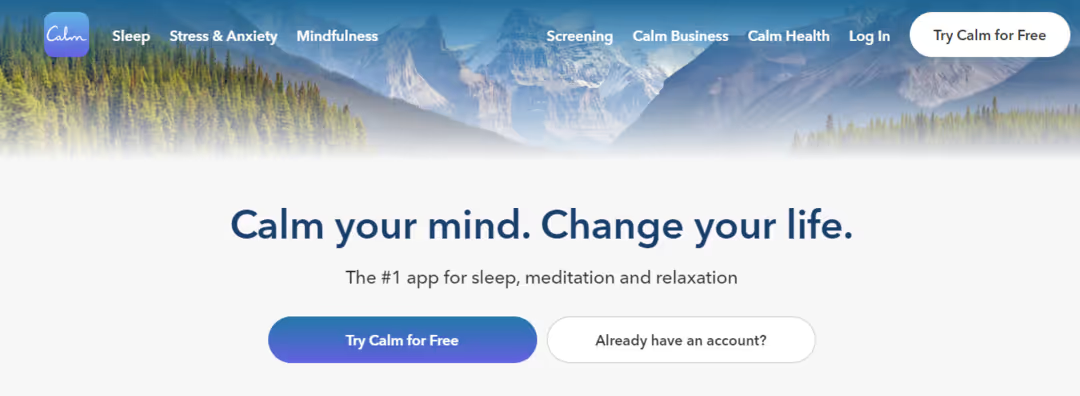
Morning rituals like stretching can be a helpful way to prepare and set intentions for the day, Austin Martinez, MS, CSCS, director of education at StretchLab in Irvine, California, tells SELF. One app he recommends for this is Calm, thanks to the depth of content and the available selection. While Calm may be best known for meditation and sleep, they recently added a Daily Move short-form video series, which includes simple exercises to get users moving.
The activities include stretching, yoga, tai chi, Pilates, and more. Each lasts about three to five minutes, perfect if you’re looking for a very short stretching routine to start your day.
Price: Free, with premium features from $15 to $70 per month.
13. Splits Training

Learning how to do the splits isn’t just a great party trick; it can help prevent injuries, relieve any muscle stiffness, increase muscle strength, and improve circulation. Whether you’re a gymnast or have never attempted the splits in your life, Splits Training will help you get there, regardless of which skill level you’re currently on. All you need is 10 minutes daily to stretch your splits.
The app offers step-by-step instructions and animated video guides to help you learn dynamic and static stretches to open your hip flexors and gain more flexibility. It also promises to have you improve your splits after 30 days of consistent practice. You can customize your own training plan within the app, and choose between beginner, intermediate, or advanced levels.
Price: This app's beginner level is free, but the intermediate and advanced levels require payment. It offers a free trial and then charges $19.99 per year for the subscription.
14. StretchIt

The StretchIt app is about setting and reaching your stretching goals to improve movement and flexibility. The app offers a variety of classes (with video demonstrations) that combine stretches from yoga, gymnastics, bodyweight training, pilates, and more, and each stretching class is sorted by categories such as bendy back, full-body stretch, or the splits. One of the great benefits of this app is that you can filter the various classes by length and difficulty to suit any time constraints or skill level you’re currently at, and offer 5 to 45-minute classes.
Another perk of this app is that you can download the stretching classes directly onto your phone, tablet, or computer if you are practicing your stretches in an area without Wi-Fi or cell service. StretchIt offers curated training programs and challenges, where you’ll take before and after pictures to track your progress. The app will ask for feedback after each class you take to further guide you towards the next one or challenge to help you push your flexibility (safely) and reach your stretching goals. StretchIt offers a free trial and charges you once that period ends.
It also offers various plans: The app costs $19.99 monthly, and annual access costs $160.
15. Down Dog
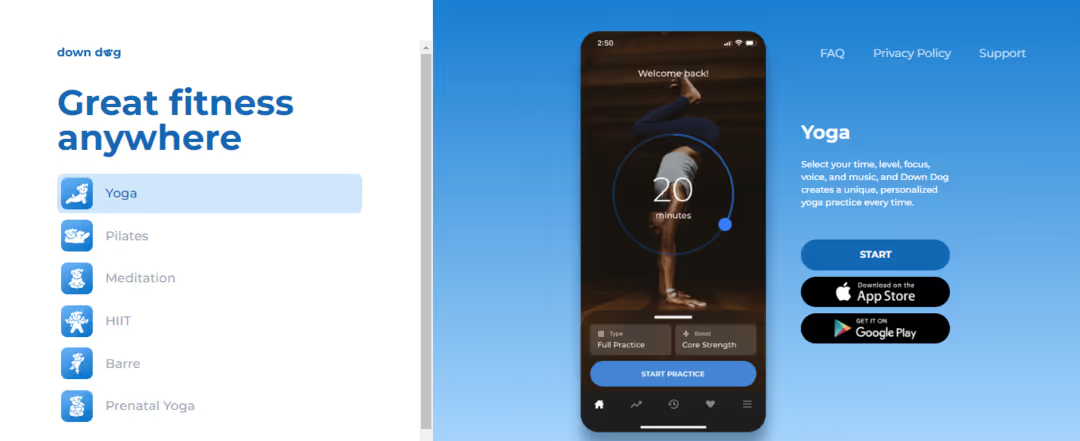
Down Dog is one of our best yoga apps - for good reason. No two Down Dog routines are the same, which is something I love about the app. There are over 60,000 different configurations, and each yoga-based stretching session will be catered to your chosen practice, experience, and pace, along with your chosen instructor and music genre. So whether you do yoga every day or you're looking for the best yoga stretches for beginners, you're sorted.
The Boost feature allows you to choose an area of the body that needs a little more attention and in response Down Dog creates a practice that ensures this focus is well stretched by the end of your routine. When I first used this app, I added a 'Boost' of neck stretches and I loved how it was seamlessly incorporated into the rest of your yoga routine. For yogis who want to improve their mobility and flexibility, or those who want a yoga-focused warm-up pre-workout, this 2-in-1 app is all you need.
Price: Free, with premium features starting at $9.99.
16. Simply Yoga – Home Instructor

This yoga app helps you build strength and flexibility. It features six level-1 routines, with certified instructors guiding you through each pose. There are also streaming yoga classes that you can tune into according to your schedule. The app details how to transition into different positions and reminds you to breathe as you move. Further, it integrates with the Apple Health app to give you an accurate representation of calories burned.
Price: Free
17. 5 Minute Pilates Workout

Pilates is an excellent way to stretch your body, enhance flexibility, and increase core strength to get in shape. This app helps you build a routine with just 5 minutes each day. All exercises come with precise descriptions and 3D animations that help you get them right, so it’s ideal for beginners, especially if you’re pressed for time. There are over 70 sessions to work through.
Price: Free (In-app Purchases start from $1.99)
18. Kaia Backpain Relief
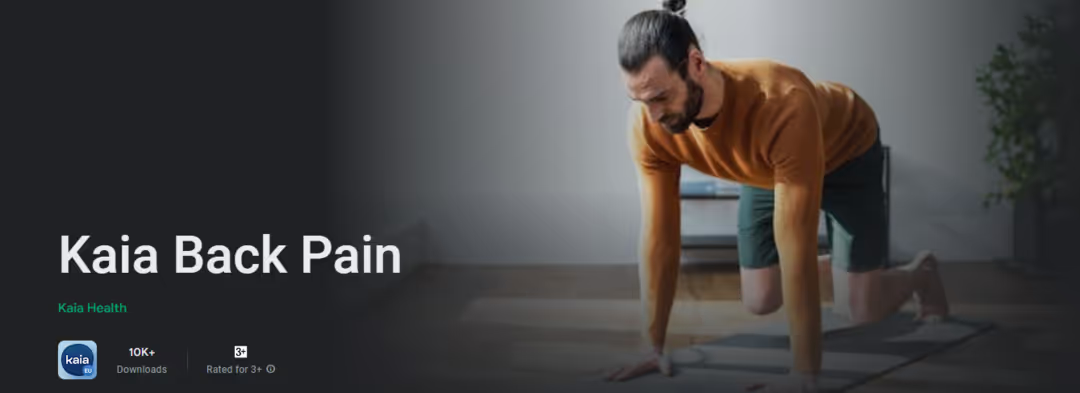
If you suffer back pain, this app can help you manage it at home with only 15 minutes of daily stretches. It offers hundreds of exercises curated and designed by doctors and health experts for back pain relief. It features intelligent algorithms that adjust the exercises to your pain level, pain localization, and daily feedback. It also combines various mobility, strengthening, and breathing exercises to address pain's physical and psychological causes.
Price: Free
19. Daily Cardio Workout – Trainer

Get in a quick 5 to 10-minute daily cardio routine from your home with this app. It features a certified personal trainer demonstrating exercises to whip your body into shape quickly. The minimal interface, complete with video and timer, allows you to follow and understand each exercise easily. It can work offline, so no matter where you are, you can get your body moving for your heart health.
Price: Free
20. Track Yoga
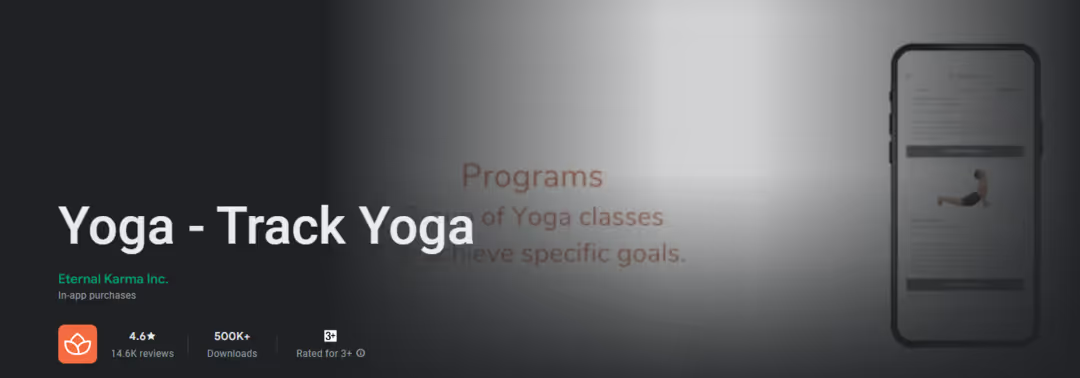
Incorporate yoga into your life with the gentle stretching classes in this app. It features sessions curated by experts to meet your specific needs, such as weight loss, improved flexibility, etc. You can set weekly goals and track your progress, collecting badges to motivate you. It has something for all your health needs, from stress relief and yoga to fight depression to travel yoga and digestion-boosting routines.
Price: Free (In-app Purchases start from $1.99)
What Should You Consider When Choosing a Stretching App?
When choosing a stretching app, consider several key features to ensure it meets your needs. Look for an app that offers stretches and routines suitable for various skill levels, from beginners to advanced users. The app should provide clear instructions, possibly with video or animation, to help you perform each stretch correctly.
Customization options are important. The ability to tailor routines to target specific muscle groups or address personal goals can enhance your experience. Consider apps that include progress tracking and reminders to keep you motivated. User interface and ease of use are also crucial, select an app that is intuitive and straightforward to navigate. Check if the app integrates with health platforms like Apple Health to sync your fitness data for a comprehensive view of your health and activity.
Related Reading
- Golf Mobility Exercises
- Upper Body Mobility Exercises
- Mobility Exercises For Runners
- Can You Over Stretch
- Squat Mobility Exercises
- Functional Mobility Exercises
- Why Stretching Is Important
- Foot Mobility Exercises
- Arm Mobility Exercises
- Hamstring Mobility Exercises
- Elbow Mobility Exercises
- Rotator Cuff Mobility Exercises
- Bed Mobility Exercises
- What Are Mobility Exercises
- Full Body Mobility Exercises
How Do You Plan a Good Stretching Program?
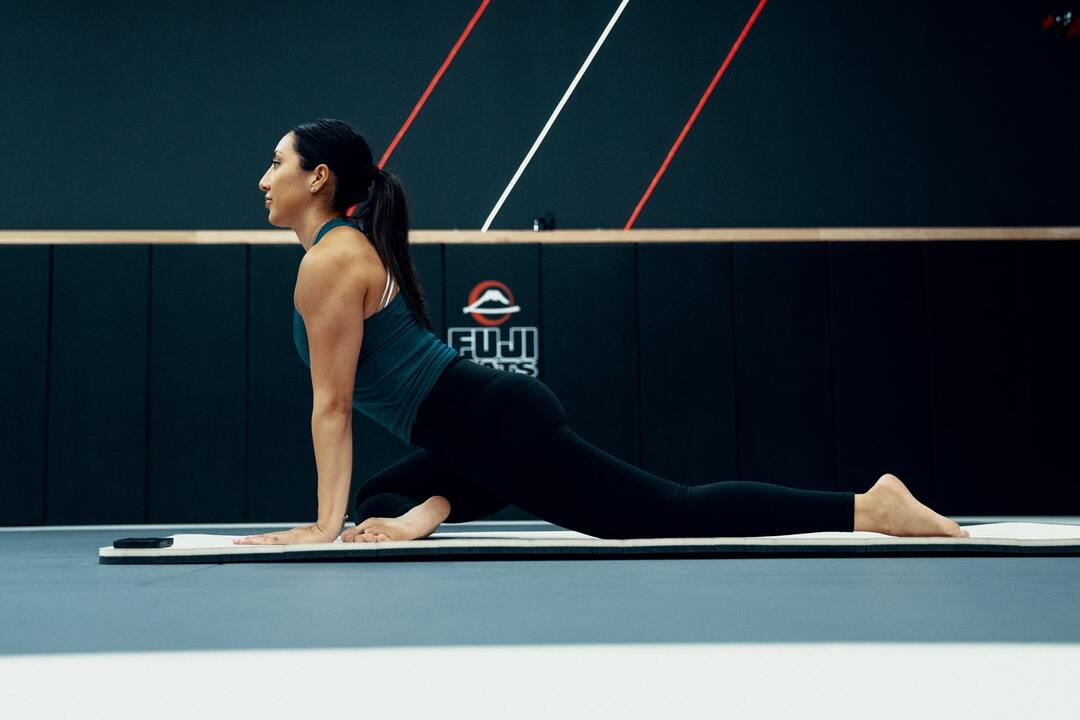
Stretching is more than a pre-or post-workout ritual. It’s a practice that should be done daily, regardless of whether or not you’ve worked out that day. “Incorporating a daily stretching routine can offer various benefits for your physical and mental well-being,” says Peloton instructor Logan Aldridge. Over time, a daily stretching routine will increase your flexibility along with improving your posture and overall athletic performance.
You shouldn’t dive into a daily stretching routine if you have a medical condition or recent injury that prevents you from doing so. “If you have had a recent injury such as a muscle strain, a joint sprain, have had surgery, or a recent fracture, you will want to check with your healthcare provider or physical therapist to ensure that [a daily stretching routine] is safe to do,” licensed orthopedic and pelvic health physical therapist, Kasia Gondek explains.
Why Should You Stretch Daily?
Logan says that stretching has several major benefits. The first and most well-known is improved flexibility through an increased range of motion. Another benefit of a daily stretching routine is improved posture. Stretching certain parts of the body targets muscles and joints that are often tight from long amounts of sitting or standing. Regular stretching also alleviates muscle tightness and tension while increasing blood flow.
According to Logan, this increase in blood flow helps improve circulation and nutrient delivery to muscle tissue. “Flexible muscles are more efficient and responsive, which can enhance your athletic performance in various activities,” Logan explains. He adds that as you maintain your daily stretching routine, you actively reduce the risk of injury to your muscles and joints. “Flexible muscles are less prone to strains and sprains,” he notes.
How Long Should You Stretch for?
Gondek says that “the best stretching routine is one that you will do.” That means fitting in as many stretches as possible on a given day. Try to stretch each of the major muscle groups in your body at least once during your daily stretching routine.
Gondek generally recommends holding individual stretches for 15 to 30 seconds for one to four reps. “Older adults need more than 30-second hold times, up to 45 seconds,” she elaborates.
Should You Change Your Stretch Routine if You Workout?
Stretching is important to do regardless of your current status with working out. While there are several stretches that you can do daily, if you work, you can tailor your daily stretching routine to your particular workout. “For people who workout regularly, a daily stretching routine also helps prevent injury and improve athletic performance,” Gondek notes. Stretching ensures that your muscles and joints have the optimal range needed to generate force and power, says Gondek.
As you stretch for your workouts, spend more time on areas of the body that will be, or have been, worked on. But don’t forget to give the other areas of your body a light stretch, too. For example, if you’re doing an upper-body workout, add more upper-body stretches while giving your lower body and core a bit of a stretch. Even though you aren’t targeting those areas, they are still working to support your upper body in its exercises.
Related Reading
- Gowod Vs Pliability
- Tennis Mobility Exercises
- Weighted Mobility Exercises
- Cervical Mobility Exercises
- Resistance Band Mobility Exercises
- Rib Mobility Exercises
- Glute Mobility Exercises
- Best Yoga App
- Mobility Apps
- Stretching Apps
- Chest Mobility Exercises
- Glute Stretches
- Gluteus Medius Stretch
- Glute Stretch
- Cervical Radiculopathy Exercises
Improve Your Flexibility with Our Mobility App Today | Get 7 Days for Free on Any Platform
Pliability is an app that offers personalized mobility routines to help athletes recover, improve flexibility, and reduce pain. The app features a library of video tutorials focusing on increasing the range of motion through dynamic warm-ups, cool-downs, and targeted mobility routines.
With Pliability, you can scan your body for mobility issues and receive customized routines to help you address your specific limitations. Pliability is a great place to start if you want to enhance your performance.

.jpg)

.jpg)




